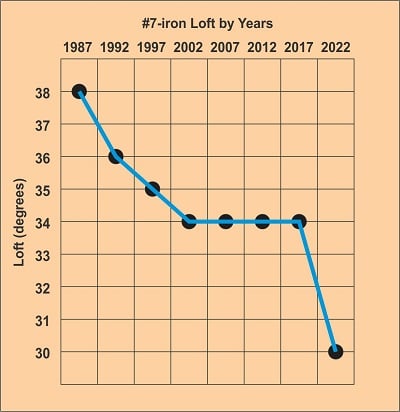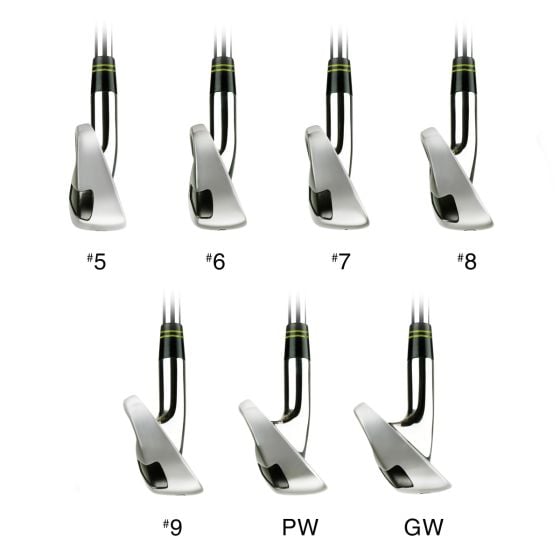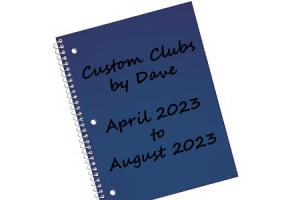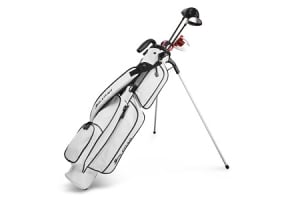
What to know about golf club iron lofts
I first started playing golf in college almost 40 years ago. The year was 1984 and Miami Vice and the Cosby Show debuted on TV, you could see Ghostbusters, Revenge of the Nerds and The Karate Kid at the movie theater, or one could rock out to Twisted Sister's "We're Not Gonna Take It" or not to Wham! Life was good and it was going to be a lot better with my newfound sport.
After I became proficient to know how far I could comfortably hit each club, I would rely on a #7-iron if I had 150 yards to the flagstick. At my peak when I played a ton of golf and was in great shape, I would use an #8-iron. Surprisingly today or 38 years later, I vacillate between a 7 or 8 iron depending upon the conditions for that same distance. How can that be? Did I drink from the Fountain of Youth or make a pact with the devil? I know it is not because I kept up my gym membership either. Of course, I no longer have those same clubs to see how I would perform with them today. So, what has allowed me to maintain or even increase my distances after all these years?
What is a #7-iron?
I feel the first thing you must understand is "what is a #7-iron"? Well, the simple answer is it is a thin, elongated club with the number 7 engraved somewhere on the sole. Back when I started playing, clubs still had numbers on the sole, but they were different critters than what we play today. I had to dig hard through old catalogs, but I found the loft of that old blade-style #7-iron that got me hooked me onto golf was around 38 degrees. For those who are much older than me might remember when irons had names rather the numbers. The modern #7-iron would have been called a Mashie Niblick.
Golf iron loft through the years
I have played long enough to experienced three different eras of loft progression in an iron set. The chart below tracks the average or typical lofts you would see in iron sets. Sure, you can find exceptions to any year, but we want to look at what was most likely played by the average golfer. 1987 (and before) falls into the traditional era. You had nine numbered irons starting with a #1 to a #9 with a pitching and sand wedge. Iron lofts ranged from 17 to 55 degrees and progressed in 3-5 degrees increments between adjacent clubs.

In 1992 began the transition to the modern lofted era which ran from 1997 up until 2017 in our 5-year subdivisions. In 1997, you could still find a 1-iron as part of some iron sets and there were a few companies producing a third wedge - called a Gap (GW) or Approach Wedge (AW) - although they were not prevalent like they are now. The reason for the extra club arose because there was greater than the acceptable 5-yard gap, hence the term "gap" wedge. 2002 was a time where the first hybrid clubs became available, and the 1-iron was soon dropped from manufacturer's product offerings. The #2-iron would later be dropped in 2017. During this span, a 7-iron loft in the modern era remained approximately 34 degrees.
Iron Lofts Through the Years (degrees)
|
||||||||
| Club | 1987 | 1992 | 1997 | 2002 | 2007 | 2012 | 2017 | 2022 |
| 1-iron | 17 | 16 | 14 | - | - | - | - | - |
| 2-iron | 20 | 18 | 17 | 17 | 17 | 17 | - | - |
| 3-iron | 23 | 21 | 20 | 20 | 20 | 20 | 20 | 17 |
| 4-iron | 26 | 24 | 23 | 23 | 23 | 23 | 23 | 20 |
| 5-iron | 30 | 28 | 27 | 26 | 26 | 26 | 26 | 23 |
| 6-iron | 34 | 32 | 31 | 30 | 30 | 30 | 30 | 26 |
| 7-iron | 38 | 36 | 35 | 34 | 34 | 34 | 34 | 30 |
| 8-iron | 42 | 40 | 39 | 38 | 38 | 38 | 38 | 34.5 |
| 9-iron | 46 | 45 | 43 | 42 | 42 | 42 | 42 | 39 |
| PW | 50 | 49 | 47 | 46 | 46 | 46 | 46 | 44 |
| GW | - | - | - | 50 | 50 | 50 | 50 | 49 |
| SW | 55 | 55 | 54 | 55 | 55 | 55 | 55 | 54 |
Today brings us to the new norm of loft progression in the iron set. In the distance era, lofts continue to range from 17 to 55 degrees and progress in 3-5 degrees increments between adjacent clubs. However, the set make-up is now 3-SW, and the 7-iron loft is down to 30 degrees or what my old 5-iron loft would have been. It is no wonder why I can continue to hit the ball as far if not further with the same numbered iron as years ago. The good news is instead of 11 clubs to span that loft range, now we only have 10 clubs to choose from.
Distance sells, but…
Hitting the ball far is one thing, but what about holding greens? Hitting the ball longer for the sake of hitting longer is meaningless unless you can stick the ball on the green and take 1 or 2 putts to get it in the hole. As mentioned previously, iron heads today are much different than there were back then. These modern, strong lofted irons are much more sophisticated and constructed of multi-materials and/or with thin faces and extremely low centers of gravity. They are also matched up with lightweight, higher launching shafts. All these features go hand in hand to normalize the ball flight you expected with previous weaker-lofted clubs and allow one to hold greens.
It will be interesting to see what happens to iron head loft in the next 20-30 years. I doubt by then I will still be able to hit a 7-iron as far regardless of what might that be. However, it makes me feel good about the current state of my game that I haven't had to "club up" as I have become older. Plus, it is much easier to strike a #7-iron solidly than it is with a longer length #5-iron.
Just know your distances you hit your irons
You can always find exceptions or outliers. This year one major manufacturer designed and sells a set of irons with the following lofts. These are most likely the strongest lofted irons on the market and require two clubs between a PW and a SW. It is not surprising that they claim them to be their longest irons. At some point it doesn't matter if the club has a number on the sole, a funny name like mashie niblick, the loft or if each iron was color coded. What matters is that you have hit the clubs with enough frequency to know what distance you can hit each one and remember it.
|
4 iron |
5 iron |
6 iron |
7 iron |
8 iron |
9 iron |
PW |
AW |
GW |
SW |
|
18.5 |
21.5 |
24.5 |
27.5 |
32 |
36.5 |
41 |
46 |
51 |
56 |
| Examples of Game Improvement Distance Irons | |
 |
 |
| Dynacraft Prophet CB | Dynacraft Prophet Muscle Blade |
 |
 |
| Power Play Juggernaut | Orlimar Intercept Single Length |





